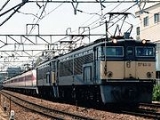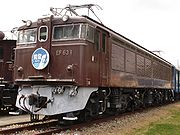
JNR Class EF63
Encyclopedia
The JNR Class EF63 is a class of 1,500 V DC electric locomotives formerly operating in Japan.
section of the Shinetsu Main Line between Yokokawa
and Karuizawa
. They replaced the Class ED42 electric locomotives previously used on the rack-and-pinion line between these two stations.
The prototype, EF63 1, was produced in 1962 by Toshiba for testing before full production of the class started in 1963 spread between manufacturers Kawasaki, Mitsubishi and Toshiba. The class was equipped with a number of special safety features to cope with the unique conditions of operating on the 66.7‰ gradient of the Usui Pass. These included independent dynamic brakes on all six axles (hence the large louvres along the bodysides for heat dissipation), magnetic adhesion brakes operating directly on the rails, and mechanical locking brakes. Small wheels attached to the centre bogie were used to measure the train speed and apply the brakes in the case of run-away. The class used the same 425 kW MT52 traction motors used on the EF62s
and also the EF70s.
The entire class was based at Yokokawa depot, and they were always used in pairs at the Yokokawa end of trains travelling in both directions, and were capable of operating in multiple with Class EF62 locomotives and a wide range of EMU types (including 115
, 185
, 189, 489 series
) – hence the impressive array of jumper cables and connectors on the Karuizawa ends of the locos. Trains ascending the incline from Yokokawa were driven by the driver in the rearmost cab of the EF63 pair at the rear of the train, with the driver in the front cab of the train acting only as signal look-out.
Locos EF63 5 and EF63 9 were written off after a runaway derailment also involving two EF62s in 1975, and EF63 24 and EF63 25 were additionally built in 1976 to replace these two.
In 1978, EF63 11 and 13 were specially turned out to work an imperial train over the Usui Pass.
Following privatization of JNR, the entire fleet was transferred to JR East operation with the exception of EF63 1 and 14 operated by JR Freight.
The closure of the Yokokawa to Karuizawa section of the Shinetsu Main Line in September 1997 coinciding with the opening of the new Nagano Shinkansen
marked the end of the careers of the EF63 locomotives. Before their final withdrawal, however, a number of locos (EF63 18, 19, 24, and 25) were repainted into original brown livery following their last overhauls in 1997. Incidentally, these locomotives were delivered in standard blue livery from new.
Source:

EF63 24 and 25 are currently used to provide driver training sessions to members of the public at the Usui Pass Railway Heritage Park
on a short stretch of track electrified at 750 V DC (rather than the normal 1,500 V). EF63 11 and 12 are kept as operational spares. All other preserved examples are kept as static exhibits.
History
A total of 25 Class EF63 locomotives were built between 1962 and 1976 exclusively for use as bankers on the steeply-graded Usui PassUsui Pass
The is a mountain pass that lies between Nagano and Gunma Prefectures in Japan. It has served as one of the major transportation routes in central Japan since at least the eighth century.- Road :...
section of the Shinetsu Main Line between Yokokawa
Yokokawa Station
is a train station in Annaka, Gunma Prefecture, Japan.-History:Yokokawa Station opened on October 15, 1885 as the terminus of the governmental railway between and Yokokawa....
and Karuizawa
Karuizawa Station
is a train station located in Karuizawa in Kitasaku District, Nagano Prefecture, Japan.-Lines:*East Japan Railway Company **Nagano Shinkansen *Shinano Railway**Shinano Railway Line-History:...
. They replaced the Class ED42 electric locomotives previously used on the rack-and-pinion line between these two stations.
The prototype, EF63 1, was produced in 1962 by Toshiba for testing before full production of the class started in 1963 spread between manufacturers Kawasaki, Mitsubishi and Toshiba. The class was equipped with a number of special safety features to cope with the unique conditions of operating on the 66.7‰ gradient of the Usui Pass. These included independent dynamic brakes on all six axles (hence the large louvres along the bodysides for heat dissipation), magnetic adhesion brakes operating directly on the rails, and mechanical locking brakes. Small wheels attached to the centre bogie were used to measure the train speed and apply the brakes in the case of run-away. The class used the same 425 kW MT52 traction motors used on the EF62s
JNR Class EF62
A total of 54 Class EF62 DC electric locomotives were built between 1962 and 1969 for use hauling passenger and freight on the Shinetsu Main Line and particularly over the extreme 66.7‰ gradient of the Usui Pass between Yokokawa and Karuizawa...
and also the EF70s.
The entire class was based at Yokokawa depot, and they were always used in pairs at the Yokokawa end of trains travelling in both directions, and were capable of operating in multiple with Class EF62 locomotives and a wide range of EMU types (including 115
115 series
The is a DC electric multiple unit train type developed by Japanese National Railways and now operated by East Japan Railway Company , West Japan Railway Company , and the Shinano Railway.-JR East:...
, 185
185 series
The is an EMU operated by East Japan Railway Company primarily on middle-distance limited express services centering on Tokyo.The class is broadly divided into two variants: 185-0 series for use south-west of Tokyo, and 185-200 series originally for use north of Tokyo.-185-0 series:The 185 series...
, 189, 489 series
489 series
The is a limited express EMU type introduced in 1972 by Japanese National Railways , and currently operated in Japan by East Japan Railway Company and West Japan Railway Company ....
) – hence the impressive array of jumper cables and connectors on the Karuizawa ends of the locos. Trains ascending the incline from Yokokawa were driven by the driver in the rearmost cab of the EF63 pair at the rear of the train, with the driver in the front cab of the train acting only as signal look-out.
Locos EF63 5 and EF63 9 were written off after a runaway derailment also involving two EF62s in 1975, and EF63 24 and EF63 25 were additionally built in 1976 to replace these two.
In 1978, EF63 11 and 13 were specially turned out to work an imperial train over the Usui Pass.
Following privatization of JNR, the entire fleet was transferred to JR East operation with the exception of EF63 1 and 14 operated by JR Freight.
The closure of the Yokokawa to Karuizawa section of the Shinetsu Main Line in September 1997 coinciding with the opening of the new Nagano Shinkansen
Nagano Shinkansen
The is a Shinkansen high-speed rail line operated by East Japan Railway Company between Takasaki and Nagano in Japan. It opened on 1 October 1997, connecting Tokyo and Nagano in time for the 1998 Winter Olympics held in Nagano...
marked the end of the careers of the EF63 locomotives. Before their final withdrawal, however, a number of locos (EF63 18, 19, 24, and 25) were repainted into original brown livery following their last overhauls in 1997. Incidentally, these locomotives were delivered in standard blue livery from new.
Locomotive histories
| No. | Built | Builder | Withdrawn |
|---|---|---|---|
| EF63 1 | 1962 | Toshiba | 1984 |
| EF63 2 | 1963 | Toshiba | 1998 |
| EF63 3 | 1963 | Toshiba | 1998 |
| EF63 4 | 1963 | Toshiba | 1998 |
| EF63 5 | 1963 | Toshiba | 1975 |
| EF63 6 | 1963 | Toshiba | 1998 |
| EF63 7 | 1963 | Mitsubishi | 1998 |
| EF63 8 | 1963 | Mitsubishi | 1998 |
| EF63 9 | 1963 | Mitsubishi | 1975 |
| EF63 10 | 1963 | Mitsubishi | 1998 |
| EF63 11 | 1963 | Mitsubishi | 1998 |
| EF63 12 | 1963 | Mitsubishi | 1998 |
| EF63 13 | 1963 | Mitsubishi | 1998 |
| EF63 14 | 1966 | Toshiba | 1984 |
| EF63 15 | 1966 | Toshiba | 1998 |
| EF63 16 | 1966 | Toshiba | 1998 |
| EF63 17 | 1966 | Toshiba | 1998 |
| EF63 18 | 1967 | Kawasaki | 1998 |
| EF63 19 | 1967 | Mitsubishi | 1998 |
| EF63 20 | 1969 | Kawasaki | 1998 |
| EF63 21 | 1969 | Kawasaki | 1998 |
| EF63 22 | 1974 | Kawasaki | 1998 |
| EF63 23 | 1974 | Kawasaki | 1998 |
| EF63 24 | 1976 | Kawasaki | 1998 |
| EF63 25 | 1976 | Kawasaki | 1998 |
Source:
Batch differences
| Batch 1: | EF63 2 – EF63 13 | Icicle cutters added above cab windscreens, rectangular front skirts |
| Batch 2: | EF63 14 – EF63 21 | Recessed tail lights, lightning protector moved to centre of cab roof |
| Batch 3: | EF63 22 – EF63 25 | Loco numbers affixed in number plate form |
Preserved examples

- EF63 1 Usui Pass Railway Heritage ParkUsui Pass Railway Heritage ParkThe is an open-air railway museum located in Annaka, Gunma, Japan. It is operated by East Japan Railway Company , and was opened on 18 April 1998 on the site of the former Yokokawa motive power depot alongside the Shin'etsu Main Line, which closed in October 1997....
, Gunma (brown livery) - EF63 2 Karuizawa StationKaruizawa Stationis a train station located in Karuizawa in Kitasaku District, Nagano Prefecture, Japan.-Lines:*East Japan Railway Company **Nagano Shinkansen *Shinano Railway**Shinano Railway Line-History:...
- EF63 10 Usui Pass Railway Heritage Park, Gunma
- EF63 11 Usui Pass Railway Heritage Park, Gunma (operational)
- EF63 12 Usui Pass Railway Heritage Park, Gunma (operational)
- EF63 13 Cab section only at Omiya Works
- EF63 15 Nagano depot
- EF63 18 Usui Pass Railway Heritage Park, Gunma (brown livery)
- EF63 19 Nagano depot (brown livery)
- EF63 22 Privately preserved
- EF63 24 Usui Pass Railway Heritage Park, Gunma (operational)
- EF63 25 Usui Pass Railway Heritage Park, Gunma (operational)
EF63 24 and 25 are currently used to provide driver training sessions to members of the public at the Usui Pass Railway Heritage Park
Usui Pass Railway Heritage Park
The is an open-air railway museum located in Annaka, Gunma, Japan. It is operated by East Japan Railway Company , and was opened on 18 April 1998 on the site of the former Yokokawa motive power depot alongside the Shin'etsu Main Line, which closed in October 1997....
on a short stretch of track electrified at 750 V DC (rather than the normal 1,500 V). EF63 11 and 12 are kept as operational spares. All other preserved examples are kept as static exhibits.

